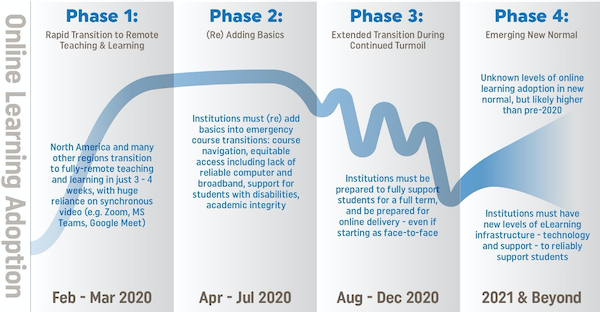Published on
Teaching in the Virtual Classroom: Strategies for Success

The COVID-19 pandemic has closed schools across the continent and sent teachers, staff and students home to work remotely. By the beginning of April 2020, it was apparent that this disruption would not be short. Instead, it would threaten the end of the school year and likely affect the start of school in September. The sequence of events–present and forthcoming–has been summarized by Hill (2020) (see Figure 1).

The first phase (February – March 2020) involved a rapid transition to remote teaching and virtual learning supported by videoconferencing tools (i.e., Zoom, WebEx, Adobe Connect). At the time of writing this paper, the second phase (April – July 2020) is unfolding and involves adding basic online education elements to websites and learning management systems (LMS). Future phases (August – December 2020) will likely be characterized by a period of preparation to support similar deliveries, only for a full term/beginning of an academic year which will differentiate it greatly from the others. The final phase, which takes us to 2021 and beyond, will see the emergence of education’s “new normal”. While schools will eventually return to traditional classroom instruction, the lessons we have all learned during this historical time will prompt us to leverage e-learning like never before.
Rationale for virtual classrooms
COVID-19 has dramatically influenced the emergence of virtual classrooms. Racheva (2018) defines the virtual classroom as an online learning environment that enables live teaching and interaction between teachers and students. The most common tools in a virtual classroom include videoconferencing, online whiteboards, instant messaging tools and breakout rooms. Rather than looking at the present-day situation as an obstacle to learning, instructors can utilize virtual classrooms as an opportunity to learn to teach in an alternate mode so that, when classrooms are re-opened, learners can experience the advantages of blended approaches (Bernard et al., 2014; Means et al., 2013).
A recent survey conducted in Ontario indicated that almost seven out of ten post-secondary students feel the online instruction they received this winter is worse than the in-person instruction they normally receive (Top Hat, 2020). Students generally found that the majority of online class experiences were unengaging. The same survey indicated that over a quarter of students are questioning whether to return to their current institution for the fall 2020 term.
The key to improving things for the fall 2020 term will be to use LMS more effectively alongside virtual classrooms to provide diverse opportunities for learning, including instant feedback, real-time interaction and engaging activities that increase motivation and participation (Racheva, 2018). A virtual classroom’s pedagogical success with post-secondary students can be enhanced through the application of four strategies: digital storytelling, a clear and lean structure, the development of a community of learners and the use of open educational resources.
Strategies to enhance virtual classrooms
Tell a story
Activities that connect learners’ interests with real-life experiences are the foundation of learning engagement (Kilpatrick, 1918). Digital storytelling is only one pedagogical approach that can engage students in deep and meaningful learning (Smeda et al., 2014). The technique can be used to integrate instructional messages with learning activities to create more exciting learning environments (Saritepeci, 2020; Smeda et al., 2014). This teaching approach enhances emotional interest and cognitive attention, and reflects consistent and reliable transfer of knowledge in line with modern learning theories. Educational technology enables learners to conduct research, write a script, and turn text, audio narration and visuals into a short video story. Learners can use Powtoon or Articulate Storyline (see appendix) to create web-based animation presentations by manipulating freely available graphic resources, imported images, music, and user-created voiceovers and tell their digital story of a particular topic.
Keep your approach clear and lean
A clear and lean structure in the virtual classroom improves interactions and learning experiences by reducing the learner’s cognitive load (Saritepeci, 2020; Smeda et al., 2014). As with traditional classroom teaching, in virtual sessions, the learning path needs to be clearly communicated to learners so they can stay on task and manage their time. A learning guide should be provided before each session and should include the name of the activity, a brief overview, requirements, the time needed to complete it, and the due date of any follow-up work. A sample of a Virtual Classroom Session Plan (developed by the Educational Development Team in McMaster University’s Continuing Education division) is included in the appendix.
When preparing teaching materials, it is important to focus on delivering small chunks of information at a time because concise and organized content allow students to revisit the material and find necessary information efficiently. Instructional content can also be made more engaging with audio narration, relevant visuals, (Fenesi et al., 2014) and short videos fewer than ten minutes (Slemmons et al., 2018).
Build a community
True engagement in virtual classrooms happens when each learner becomes part of a learning community. All students possess unique skills, experiences and backgrounds that they can share with others to enrich everyone’s learning (Vygotsky, 1978). Most videoconferencing tools have breakout rooms that can be set for project-based group work in real-time or within an LMS asynchronously.
Learners can also participate in video discussions using Flipgrid (see appendix), collaborate on developing an interactive historical timeline using Timeline JS (see appendix), create a wiki article with WikiEdu (see Appendix), or design a multimedia interactive poster Glogster (see appendix). Professors may need to demonstrate how to use these tools, but post-secondary students will most likely adapt to them quickly. Additionally, they provide a platform for collaboration and community building, skills that are sought after by many employers (Deloitte Access Economics, 2017).
Add Open Educational Resources
Open Education Global (formerly known as Open Education Consortium) defines open educational resources (OERs) as “teaching, learning and research materials in any medium–digital or otherwise–that reside in the public domain or have been released under an open license that permits no-cost access, use, adaptation and redistribution by others with no or limited restrictions” (What We Do – OE Global, n.d., para. 3).
One significant benefit of moving to OERs is increased access to free high-quality educational resources. Diversifying content increases engagement and enhances the learning experience, particularly for students with special accommodation requests (Capp, 2017). The savings enabled by OERs are significant. In Ontario alone, since March 1st, 2019, eCampusOntario has reported over $10 million in student savings due to the reduction of mandatory textbooks fees through adopting OERs at all levels of education (eCampusOntario Open Library Portal, n.d.). Thousands of free instructional objects can used with post-secondary students in some of the larger OER repositories: MERLOT, Project Gutenberg, ACT Academy, and OER Commons (see appendix for details).
COVID-19 has disrupted education for all stakeholders. Classes once held in brick-and-mortar classrooms have now moved to virtual environments. When we return to physical classrooms, we should not simply return to the teaching and learning practices we used before the pandemic. Instead, post-secondary instructors’ tool kits should include new resources and strategies. Professional development should be sustained so teachers are better prepared in the in virtual classrooms. While the four strategies described in this article can serve as a foundation for those unfamiliar with virtual classrooms, they are by no means indicative of all the possibilities available to us. Piloting and evaluating the many virtual strategies post-secondary school professors can use is strongly recommended and can certainly lead to opportunities for further research.
Disclaimer: Embedded links in articles don’t represent author endorsement, but aim to provide readers with additional context and service.
References
Bernard, R. M., Borokhovski, E., Schmid, R. F., Tamim, R. M., & Abrami, P. C. (2014). A meta-analysis of blended learning and technology use in higher education: From the general to the applied. Journal of Computing in Higher Education, 26(1), 87–122. https://doi.org/10.1007/s12528-013-9077-3
Capp, M. J. (2017). The effectiveness of universal design for learning: A meta-analysis of literature between 2013 and 2016. International Journal of Inclusive Education, 21(8), 791–807. https://doi.org/10.1080/13603116.2017.1325074
Deloitte Access Economics. (2017). Soft skills for business success: Building Australia’s future workforce (p. 44).
ECampusOntario Open Library Portal. (n.d.). Welcome to the Open Library The Home of Open Educational Resources (OER) in Ontario. Retrieved April 21, 2020, from https://openlibrary.ecampusontario.ca/
Fenesi, B., Heisz, J. J., Savage, P. I., Shore, D. I., & Kim, J. A. (2014). Combining best-practice and experimental approaches: Redundancy, images, and misperceptions in multimedia Learning. The Journal of Experimental Education, 82(2), 253–263. https://doi.org/10.1080/00220973.2012.745472
Hill, P. (2020, March 31). Revised Outlook for Higher Ed’s Online Response to COVID-19. PhilOnEdTech. https://philonedtech.com/revised-outlook-for-higher-eds-online-response-to-covid-19/
Kilpatrick, W. H. (1918). The Project Method: The Use of the Purposeful Act in the Educative Process. Teachers College, Columbia University. http://archive.org/details/projectmethodus00kilpgoog
Mayer, R. E., & Moreno, R. (2003). Nine ways to reduce cognitive load in multimedia learning. Educational Psychologist, 38(1), 43–52. https://doi.org/10.1207/S15326985EP3801_6
Means, B., Toyama, Y., Murphy, R., & Baki, M. (2013). The effectiveness of online and blended learning: A meta-analysis of the empirical literature. Teachers College Record, 115, 47.
Racheva, V. (2018, May 9). What is a Virtual Classroom? – Definition. VEDAMO. https://www.vedamo.com/knowledge/what-is-virtual-classroom/
Saritepeci, M. (2020). Students’ and Parents’ Opinions on the Use of Digital Storytelling in Science Education. Technology, Knowledge and Learning. https://doi.org/10.1007/s10758-020-09440-y
Slemmons, K., Anyanwu, K., Hames, J., Grabski, D., Mlsna, J., Simkins, E., & Cook, P. (2018). The impact of video length on learning in a middle-level flipped science setting: Implications for diversity inclusion. Journal of Science Education and Technology, 27(5), 469–479. https://doi.org/10.1007/s10956-018-9736-2
Smeda, N., Dakich, E., & Sharda, N. (2014). The effectiveness of digital storytelling in the classrooms: A comprehensive study. Smart Learning Environments, 1(1), 6. https://doi.org/10.1186/s40561-014-0006-3
Top Hat. (2020). Adrift in a Pandemic: Survey of 3,089 Students Finds Uncertainty About Returning to College [Survey]. https://tophat.com/press-releases/adrift-in-a-pandemic-survey/
Vygotsky, L. (1978). Mind and society: The development of higher mental processes. Harvard University Press.
What We Do – OE Global. (n.d.). Retrieved April 20, 2020, from https://www.oeglobal.org/about-us/what-we-do/
Appendix: Online Tools and Resources for Virtual Classrooms
| Online resources | Type | URL |
| Powtoon | A tool to create video presentations | https://www.powtoon.com |
| Articulate Storyline | A tool to develop interactive videos | https://articulate.com |
| Flipgrid | Video discussion | https://info.flipgrid.com |
| Timeline JS | A tool that enables visually rich, interactive timelines to be designed. | http://timeline.knightlab.com |
| WikiEdu | A tool to create knowledge repositories collaboratively | https://dashboard.wikiedu.org |
| Glogster | A tool to create multimedia interactive posters | https://edu.glogster.com |
| MERLOT | OER repository | https://www.merlot.org/merlot/index.htm |
| Gutenberg | OER repository | https://www.gutenberg.org |
| ACT Academy | OER repository | https://actacademy.act.org/search |
| OER Commons | OER repository | https://www.oercommons.org |
| Virtual Classroom/Synchronous Session Guide | Template | http://libguides.mcmaster.ca/c.php?g=702005&p=4988772 |
Author Perspective: Administrator



